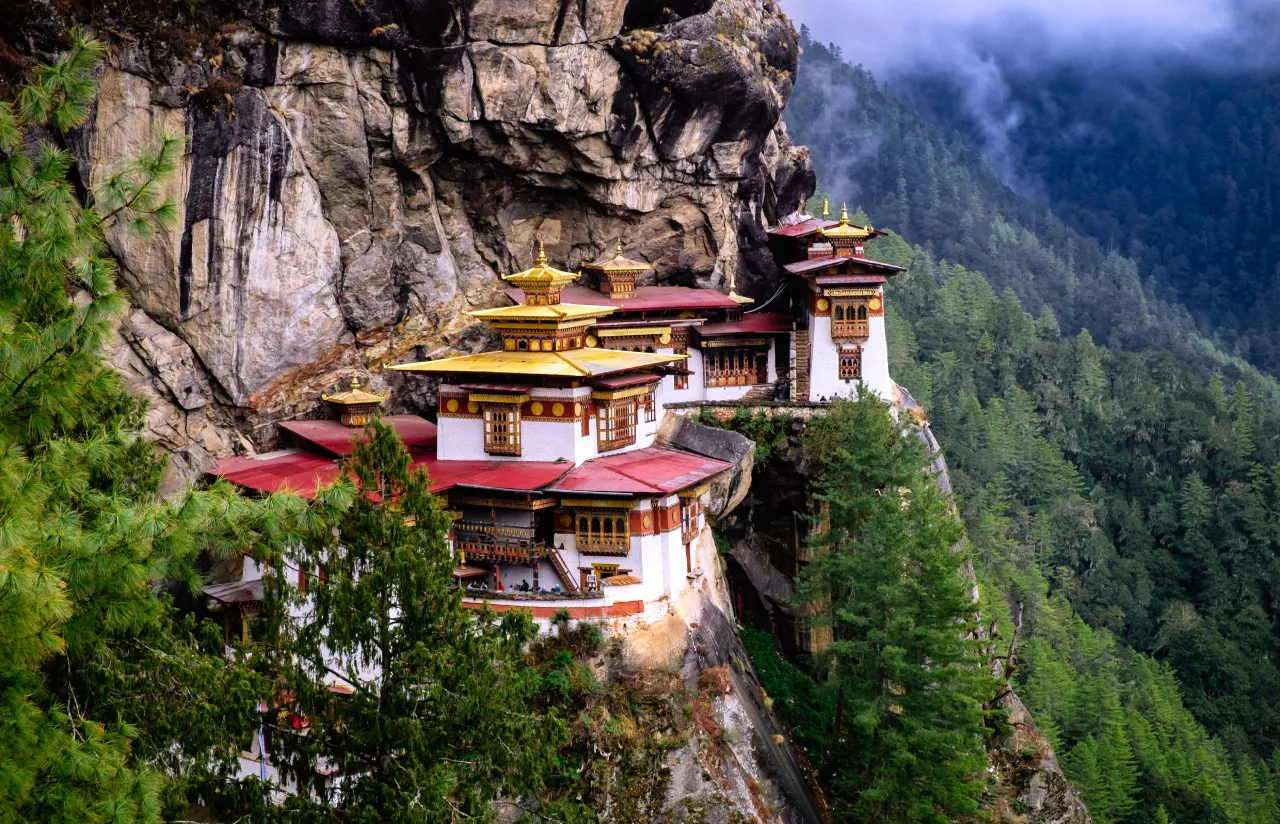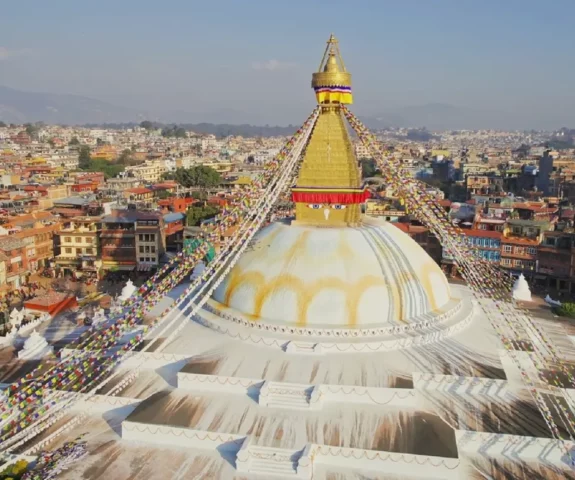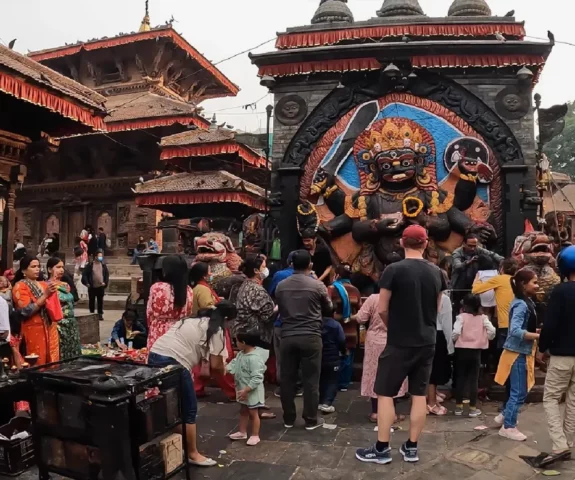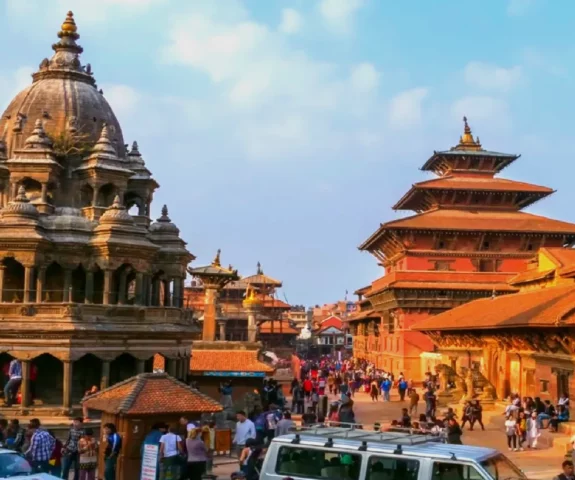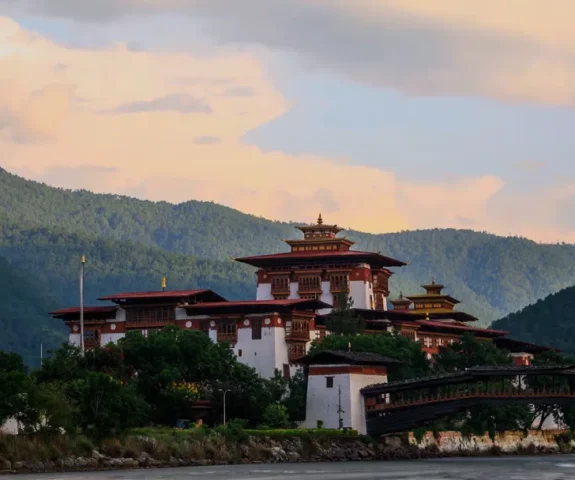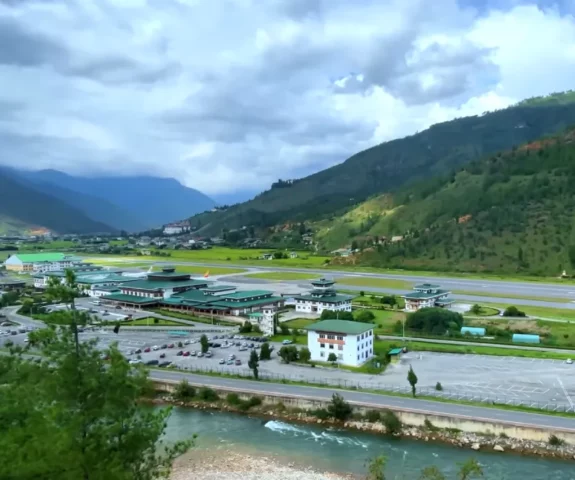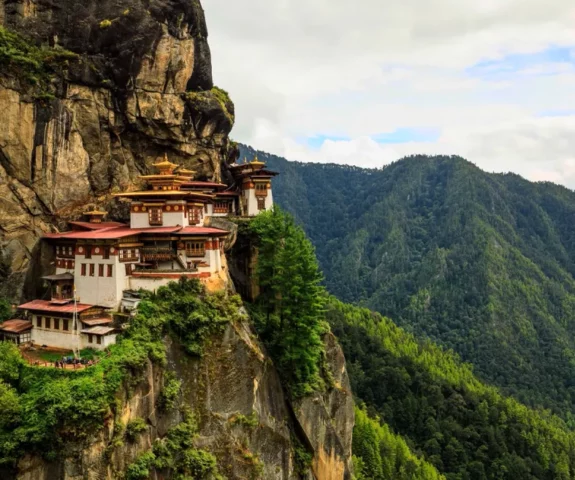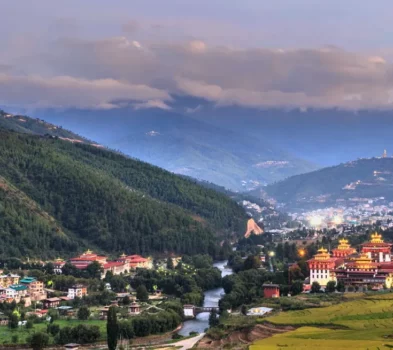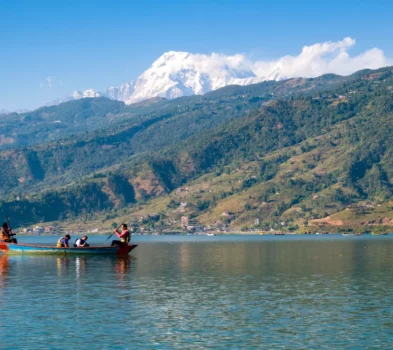Duration
13 DaysNepal and Bhutan Tour
Trip Grade
EasyGroup Size
1-16 PeopleMax Altitude
3,215m. / 10,548ft.Best Season
Feb- May/ Sept-NovActivity
Long TourMeals
Breakfast, Lunch & DinnerAccommodation
Hotels & ResortsTransportation
Private Vehicle & FlightTrip Customization
On request (click here)Highlights of Nepal and Bhutan Tour
- Discover the lesser-known and popular attractions of Kathmandu City
- Feel the tranquility and the religious essence at Boudhanath and Swayambhunath
- Witness the never-ending cycle of birth and death at Aryaghat of Pashupati
- See and feel the distinct charm and cultural wealth of Bhaktapur and Patan
- The astoundingly striking sunset and sunrise from Nagarkot Hill
- Spend a day with the rare and threatened wildlife in Chitwan
- Get to know the kind-hearted Tharu and their extraordinary culture
- Explore the wonders of Pokhara and see Nature’s masterpieces intermingling with human creativity
- Enjoy the out of the world mountain flight to Paro
- Walk up to the cliff of the Tiger’s Nest Monastery
- A fulfilling day in the out-of-ordinary capital of Thimphu
- See the historical beauty of Punakha, the former capital of Bhutan
Trip Introduction
Himalayan Adventure invites you on a 13-day long Nepal Bhutan tour- a journey to two Kingdoms isolated by the high Himalayan ranges, two lands of rich culture, stunning landscapes, and ancient traditions. These are the countries that open the doors to a world of harmony and serenity that has almost disappeared in other places on our planet.
Nepal and Bhutan have always aroused the intrigue and curiosity of travelers. That’s why we created the rare itinerary in our Nepal and Bhutan tour package that will take you to meet the most secret of the two Himalayan kingdoms and will reveal a rich and surprising culture that is still too little known.
The first part of our Nepal Bhutan tour is focused on Nepal, where you will get to know the lesser-known sides of the Kathmandu Valley with larger classic attractions.
You will begin with Kathmandu, the city where the mystique of the East is found in everyday life. From the most sacred Hindu Pashupatinath Temple to the large Buddhist area at Boudhanath and Swayambhunath, from the old part of Newari architecture at Kathmandu Durbar Square to the striking originality in Patan and Bhaktapur, you will see and experience everything.
Then, Nagarkot Hill awaits you, laden with the most panoramic views that will simply take your breath away. Next, following the old caravan town of Bandipur, you will reach the world of rhinos and tigers in Chitwan National Park.
One of the most visited and most well-known parks of Nepal, it boasts varied biotopes- dense forests, tall grasses, and calmly flowing rivers of Narayani, Reu, and Rapti. Then, passing through beautiful forest areas and mountain valleys with rice fields and small villages, you will arrive in Pokhara.
It lies strangely by the large Fewa Lake in a green and lush Valley. Annapurna, sacred Fishtail, and Dhaulagiri frame the city, where you will take a tour of its insightful caves, lakes, monasteries, and waterfalls.
Experiencing Nepal from the highlands to the lush lowlands, you will then return to Kathmandu with a detour to the desire fulfillment temple of Manakamana.
Now, the second part of our tour package to Nepal and Bhutan begins, which will fly you to the Himalayas’ easternmost country and last kingdom, Bhutan, which has Tibetan Buddhism as its state religion.
In Bhutan, you will visit Bhutan’s golden triangle with the old winter capital of Punakha, the capital Thimphu, and the Paro Valley, a beautiful and famous small valley of the Kingdom.
In Paro, your most wonderful highlight will be the upward hike and the excursion tour of the Tiger’s Nest Monastery, which sits like a bird’s nest on a 3120 m steep cliff.
Then, taking the most beautiful trail through the lovely forest, you will cross the Dochula Pass and reach Punakha- the old capital with the monastery castle Punakha Dzong, which is one of Bhutan’s most beautiful.
The journey from Punakha will then lead you to Thimphu- one of the most unusual capitals of the world. The most enchanting landmark here will be the 50 m tall giant bronze statue of Buddha.
After experiencing the best of Bhutan, you will now journey onward to your next destination from Paro Airport, concluding the amazing Nepal Bhutan tour.
It is a trip perfect for anyone and doable in any dry season of autumn, winter, or spring. Welcome to a Himalayan cultural journey with insights into the Nepal and Bhutan tour that has a class of its own.
Outline Itinerary of Nepal and Bhutan Tour
Day 01: Arrival at Kathmandu Airport.
Day 02: Sightseeing in Kathmandu Valley.
Day 03: Sightseeing in Patan & Bhaktapur, Overnight at Nagarkot.
Day 04: Drive from Nagarkot to Chitwan.
Day 05: Jungle Adventure at Chitwan National Park.
Day 06: Drive from Chitwan to Pokhara.
Day 07: Sightseeing in Pokhara Valley.
Day 08: Drive from Pokhara to Kathmandu via Manakamana Temple.
Day 09: Fly from Kathmandu to Paro.
Day 10: Hike in Paro (Tiger’s Nest Monastery)..
Day 11: Drive from Paro to Punakha and Sightseeing.
Day 12: Drive from Punakha to Thimphu & Sightseeing.
Day 13: Departure from Paro.
Our guests sharing their experiences (Photo/Video Gallery)
Detail itinerary of Nepal and Bhutan Tour
Day 01: Arrival at Kathmandu Airport.
Welcome to the intriguing capital, Kathmandu. After the meet and greet program from our staff at TIA, we will gently escort you to your finest hotel in the city.
Please unwind and make yourself comfortable while we wait for all our participating members to arrive in Kathmandu. After some refreshments, you can venture out and explore the encircling street to know slightly about the people, and the environment of this picturesque city.
Later in the evening, our assigned tour guide will meet and greet you all and offer a detailed orientation about the planned travel program of our Bhutan and Nepal tour. Go out and take the first bite of the exceptional Nepali cuisine in the city.
Activity: Airport Pickup, 30 min
Max. Altitude: 1,400m/4,593ft. Kathmandu
Accommodation: Hotel
Day 02: Sightseeing in Kathmandu Valley.
We have planned for you a full day out in the Kathmandu city. After breakfast, we will take you to the Pashupatinath Temple and its complex. This beautiful pagoda-style temple will only allow the Hindu followers to enter but we can get around the Aryaghat lying peacefully by the shore of the Bagmati River. It is the Hindu funeral site where the cremation takes place.
We will then go to the white semicircle stupa of Boudhanath which is said to have contained the remains and various artifacts of Buddha. Believed to be the connecting stair between earth and heaven, this stupa sees countless pilgrims (both Hindus and Buddhists) during the day.
After the stupa exploration and some shopping in the colorful Boudha market, we will not take you to Swayambhunath stupa. More than 2500 years old, this temple overlooks the entire direction with the all-seeing peaceful eyes of the great Buddha.
It’s already evening, now we will travel to the old palace square of Kathmandu where the sparkling street lights illuminate every temple, every pagoda, and every monument of the square.
If the fortune goddess blesses us, we may see a glimpse of the virgin goddess Kumari peeking from the window of her palace. The giant red statue of Hanuman (the Monkey God) seems to guard the old palace gate now turned into a museum.
There is also the enormous blue and black Kal Bhairav, the Taleju Bhawani Temple, and the Makkhan Mahadev Temple for us to pray. We can now head back to our hotel for dinner or choose one of the musical Thamel restaurants for the late-night charm.
Activity: Sightseeing, 5-6 hours
Max. Altitude: 1,400m/4,593ft. Kathmandu
Meal: Breakfast
Accommodation: Hotel
Day 03: Sightseeing in Patan & Bhaktapur, Overnight at Nagarkot.
We have divided today into three parts: in the first part we will be visiting the Palace Square of Patan, one of the three former royal cities of the Kathmandu Valley. It has a mix of the old royal court, artistic workshops, and temples.
The most significant and the most architecturally beautiful ones are the Krishna Mandir built in the traditional Indian Shikhara style and the other is the Golden Temple of Hiranaya Varna Mahavir built following the old Nepalese Bahal style.
We will now get on to the second part of the day which will take us to the third Palace Square of the Valley: the Bhaktapur Palace Square. Located inside one of the best-preserved medieval cities of the world, it is mainly admired for the architecture of the buildings and the beauty of the temples.
The Golden Gate, the 55 windows Palace, the mini Pashupati, the lion gate, and the Nyatapole are some iconic structures to admire.
Now, the third part of the day will lead us on the eastern side of Kathmandu to the beautiful hilltop of Nagarkot perched at 2175 m elevation. It is the ideal place to admire the mountain peaks of the Himalayas so we will stay the night here.
Activity: Sightseeing, 5-6 hours
Max. Altitude: 2,175m/7,136ft. Nagarkot
Meal: Breakfast & Dinner
Accommodation: Hotel
Day 04: Drive from Nagarkot to Chitwan.
Before the sun prepares to rise, we will be present at the view tower of Nagarkot. The tranquility, blissful peace, and fresh wind born from the surrounding mountains already allure us.
But as the sun starts to awaken everything around us, we will see the new shadows of Manaslu, Ganesh, Langtang, Gaurishankar, Numbur, Dorje Lhakpa, and the beautiful Everest. After witnessing the born of the new day along the mountains, we will now travel back to our lodging for some breakfast.
We will now prepare to depart for the terrain plain in the southern part of Nepal- to the hot and humid Chitwan and its Park. From Nagarkot, we will follow the Nagarkot Road for a while, then the Araniko Highway of Bhaktapur will take us forward towards the broad Prithvi Highway.
The mountains and green hills will pass rolling by as we press on towards the Narayangadh – Muglin Highway. Soon we will come to the Bypass road that will lead us to Bharatpur.
Continuing along, the Gitanagar and the Gitanagar-Patihani Roads will advance us to Sauraha Road indicating we have approached our destination.
The Chitwan National Park used to be the favorite hunting ground of royalties and British officials. It has now transformed into a safe and protective haven for the threatened wildlife where we can see them in their natural environment.
The Shivalik hills are part of the park which is decorated with deciduous forests. It lies along the shores of three beautiful waters of Narayani, Reu, and Rapti.
The main source of the park that attracts visitors are the Asian one-horned rhinoceroses and Royal Bengal tigers which often hide in the dense part of the park.
There are also macaques, langur monkeys, deer, leopards, gaurs, wild boars, wild dogs, wild cats, pythons, the endangered gharial, marsh crocodiles, and freshwater dolphins which have made the park their home.
Activity: Drive & Jungle Activities, 5-6 hours
Max. Altitude: 415m/1,362ft. Chitwan National Park
Meal: Breakfast, Lunch & Dinner
Accommodation: Resort
Day 05: Jungle Adventure at Chitwan National Park.
We have planned for you a very exciting day filled with action in the Chitwan National Park. After breakfast, we can go on the jungle adventure either on foot, jeep or on an elephant.
In our opinion, the best option will be to walk through the thickets of the forest in the company of expert forest guides. We can go to such secluded corners of the forest unreachable by jeep or elephant.
The second best option will be to take a four-hour jeep safari which provides an excellent opportunity to view exotic wildlife and birds. We don’t suggest you ride elephants for safaris keeping in view the welfare of these big beautiful creatures.
After the safari is complete, we can visit the breeding center of elephants where we can engage in feeding and bathing the young elephants. We can also go canoeing on the Narayani River which is made from tree trunks.
Later in the evening, we will visit the Village of the Tharu people who will entertain us with their cultural Tharu Stick Dance Show.
Activity: Jungle Activities, 6-7 hours
Max. Altitude: 415m/1,362ft. Chitwan National Park
Meal: Breakfast, Lunch & Dinner
Accommodation: Resort
Day 06: Drive from Chitwan to Pokhara.
It’s now time that we head to Nepal’s recently declared Tourism Capital- the Pokhara Valley. Taking the Sauraha Road, we will travel to the Gitanagar-Patihani and Gitanagar Roads to reach the Mahendra Highway of Bharatpur.
After an hour or so, we will reach the familiar Narayangadh – Muglin which after some point meet the Prithvi Highway which through Bandipur and Byas leads us to Pokhara.
The paradise city is nestled beneath the prominence of the massive Annapurna range to Dhaulagiri, the holy Fishtail (Machhapuchhre), and Manaslu.
Besides the mountains, the city also flaunts charming lakes such as Rara, Fewa, and Begnas while also enchanting hills such as Sarangkot. We will get on with the tour in Pokhara the next day, for now, we will just rest and enjoy some peaceful time by the Lakeside near Fewa Lake.
Activity: Drive, 4-5 hours
Max. Altitude: 822m/2,697ft. Pokhara
Meal: Breakfast
Accommodation: Hotel
Day 07: Sightseeing in Pokhara Valley.
Pokhara is a delight to the sore eyes as we see the outlines of icy mountains all around. In the morning, you may take an upward hike to the View Tower of Sarangkot from where you will see the majestic beginning of a new day as the rising sun awakens the sleeping giants of Annapurna and Dhaulagiri range.
After breakfast, we will then set out to explore the astonishing natural structures of Pokhara that don’t seem to amaze us, such as the magnetic Gupteswor Cave, the Devi’s Falls, the Bat Cave, and the Mahendra Cave.
Then we will move on to see some man-made wonders such as the World Peace Pagoda, the International Mountain Museum, the Refugee Camp, Seti Gorge, and the Kali Temple.
For the relaxing evening, we will simply hire a boat and drift along the calm waters of Fewa Lake where the reflection of Fishtail Mountain adds to the tranquility. The evening will be more charming as we enjoy our meal to the beat of the loud music.
Activity: Sightseeing, 5-6 hours
Max. Altitude: 822m/2,697ft. Pokhara
Meal: Breakfast
Accommodation: Hotel
Day 08: Drive from Pokhara to Kathmandu via Manakamana Temple.
To get on with our Nepal Bhutan tours, we must head back to Kathmandu. Following the Prithvi Highway, we will take the long road enjoying the speeding scenery of the green hills and the white images of the high peaks.
We will soon reach Kuringtar in Darechok where we will stop and take a cable car ride to the 1300 m green hill. The Manakamana Temple smiles upon us as we keep on progressing with our ride.
She is another holy and calm form of Goddess Durga who blesses all her devotees and grants their deepest wishes. We will also take some moments to offer our prayers and then head down to our transport.
It will again traverses the Prithvi Highway this time taking us to the Trishuli Valley. Kathmandu is not very far as by the early evening, we will be once again in the enchanting chaotic atmosphere of the capital.
We will spend the evening resting in our room, as we will be flying to the highland region of Paro the next morning.
Activity: Drive & sightseeing, 8-9 hours
Max. Altitude: 1,400m/4,593ft. Kathmandu
Meal: Breakfast & Dinner
Accommodation: Hotel
Day 09: Fly from Kathmandu to Paro.
Early morning we will transfer- out to TIA and take the flight to spectacular Paro. Flying over the Nepali sky, we can see the Kanchenjunga, Everest, and Makalu shining below us.
As we start to approach the Bhutan sky, the Jomolhari, and the Jichu Drake peaks start to decorate the horizon. Soon, the majestic Paro plateau will be before our eyes.
As soon as we exit the flight, we will be greeted by the cool and refreshing Bhutanese highland air. At the airport, we will meet our assigned local guide who will assist us in reaching our hotel in Paro.
Please take adequate rest and begin to hydrate yourself even if you are not feeling thirsty as we have ascended to 2200 m altitude in just a matter of an hour.
Aside from the legendary rock monastery of Tiger’s Nest or Taktshang, the town also consists of picturesque walking trails and workshops of artistic crafts.
In the evening, we can venture out and walk the lighted street of Paro and see the brightened Paro fortress up in the distance.
Activity: Flight & Sightseeing, 4-5 hours
Max. Altitude: 2,200m/7,218ft. Paro
Meal: Breakfast, Lunch & Dinner
Accommodation: Hotel
Day 10: Hike in Paro (Tiger’s Nest Monastery)..
We will begin our morning with about a 15-minute drive and a three to four-hour uphill walk up to the 3120 m high cliff. It is here that the most legendary Tiger’s Nest monastery is perched up.
Removing our shoes, we will have the privilege of taking a look inside the Thousand Buddha Hall where the fabled tigress statue is kept. Then walking across the stone bridges, we will venture into one after another chamber and see the prayer wheel, scriptures, thangkas, and paintings.
We will then proceed to visit the Kichu Lhakhang temple, the National Museum located in the ancient clock tower, and Paro Dzong erected by the founder of Bhutan in the 17th century. We may also explore the Drukgyal Dzong fortress located around 16 km afar from Paro.
In the evening, we will then stroll along the main street of Paro. There are countless shops where you can find household items, exceptional thangkas, jewelry, traditional organic cosmetics and perfumes, incense, local herbal teas, coffee, spices, as well as the most expensive cordyceps mushrooms.
Activity: Hike, 7-8 hours
Max. Altitude: 2,200m/7,218ft. Paro
Meal: Breakfast, Lunch & Dinner
Accommodation: Hotel
Day 11: Drive from Paro to Punakha and Sightseeing.
On our travel program today, we will set our sights on Punakha, the former capital and now the winter home of the spiritual authority of Bhutan.
From Paro, we will proceed along the Paro-Thimphu Highway to arrive at Bumthang. From here, we will journey along the Phuentsholing Highway, which will eventually lead us to the Thimphu Highway and Semtokha Dzong.
By the royal command of Shabdrung Ngawang Namgyal, this dzong was founded in 1629 AD. We will now resume along the long Trashigang Highway that runs parallel to the stunning rhododendron forests, fields of dwarf bamboo, and beautiful waterfalls until we arrive at the 3100 m high Dochula pass.
Atop the Pass, we will find the collection of 108 stupas which is collectively named Druk Wangyel Chorten. Around the stupa, the Tsa Tsa (the cylindrical jars) containing the ashes of the soldiers who died during the war with Assam in 2003 are preserved.
The Pass also blesses us with the first sight of the Jejegangphugang (7,158 m), Terigang (7,060 m), Masagang (7,158 m), Tsendagang (6,960 m), Zongphugang (7,060 m), Gangkar Puensum (7,497 m), and Kangphugang (7,170 m) Peaks. We will then descend into the lush subtropical valley of Punakha.
We will take some time to get comfortable in our accommodation, then we will go out to visit the majestic Punakha Dzong. It rises above the confluence of two rivers: the Mother River Mo Chu and the Father River Phu Chu.
This is one of the most impressive Bhutanese fortresses, also called the Palace of Utmost Happiness. Mighty and impregnable from the outside, the fortress inside is embellished with wood carvings, bright red, gold, and black colors that please the eye, and magnificent wall paintings on religious and historical subjects.
After completing the tour of the Dzong, we will take an hour-long drive towards Wangdiphodrang which helped to unify Bhutan to its current form.
It is situated high above the Bhajotang the offers the astounding spectacle of the rural setting of Bhutan. We will now end our day and proceed back to our accommodation.
Activity: Drive & sightseeing, 5-6 hours
Max. Altitude: 1,310m/4,298ft. Punakha
Meal: Breakfast, Lunch & Dinner
Accommodation: Hotel
Day 12: Drive from Punakha to Thimphu & Sightseeing.
The morning in Punakha is worth a visit to the Chimi Lhakhang Monastery, known as the Fertility Temple (optional). On the way, you will see numerous residential buildings, the walls of which are decorated with images of mythical animals, as well as images of phalluses of various shapes and sizes, which serve as symbols of wealth, fertility, and good luck.
We will now leave Punakha and travel along the Punakha-Gasa Highway. We will re-cross the Dochula Pass and head towards Bumthang and reach Semtokha Dzong once again.
From this location, we will take the Trashigang Highway, which will eventually connect us to the Thimphu Highway. In roughly one hour, we will arrive at Thimphu, the current capital city of Bhutan.
You will be amazed to see no traffic lights and one traffic policeman regulating the street traffic of the capital. You will also see a 50 m bronze Buddha Statue towering over the city, guarding its peace and quietness.
After a much-needed lunch, we will now go to visit the largest building of the capital – the fortress Tashicho Dzong which houses the throne room, numerous government offices, and the summer residence of the chief abbot.
We will then continue with our tour and see the Memorial Stupa – a small elegant temple in Tibetan style, erected in memory of the Third King of Bhutan (Jigme Dorji Wangchuck) by his mother.
If we have time, we may also go to see the Gagyel Lhundrup weaving center – the place where the fabrics for the ceremonial clothes of the royal family are created, the Zorig Chosum art school, the interactive museum Simply Bhutan, the National Library and the national paper factory.
Activity: Drive & Sightseeing, 5-6 hours
Max. Altitude: 2,400m/7,874ft. Thimphu
Meal: Breakfast, Lunch & Dinner
Accommodation: Hotel
Day 13: Departure from Paro.
Early morning will see us driving from Thimphu to Paro. En route, we will make a short stop at the confluence of two rivers – Paro and Wang, where three stupas have been erected in Bhutanese, Tibetan, and Nepalese styles (according to beliefs – protectors of an important crossroad from evil spirits).
We will then proceed to Paro International Airport, where you will say farewell to our local guide before departing for your onward destination.
Activity: Airport drop, 30 min
Max. Altitude: 2,200m/7,218ft. Paro Airprt
Meal: Breakfast
Note:
If you have your own private group and want to make your trip private, we can run the custom trip all the day as per your requirements and group size.
Includes and Excludes
What are included with package?
- Pick up & Drop from the Airport and Transfer to the Hotel: Airport transfers by private vehicle for convenience and comfort.
- Three Nights’ 3-star Hotel in Kathmandu with Breakfast: Stay at a 3-star hotel in Kathmandu with breakfast included to start and end your trip comfortably.
- Two Nights’ 3-star Hotel in Pokhara with Breakfast: Accommodation in a 3-star hotel in Pokhara, including breakfast, to relax after your sightseeing.
- Two Nights’ 3-star Hotel in Chitwan with Full Board Meals: Full board meals (breakfast, lunch, and dinner) included during your stay in Chitwan.
- Four Nights’ 3-star Hotel in Bhutan with Full Board Meals: Stay in Bhutan with full board meals included to ensure comfort and nourishment.
- National Park Fees for All Activities in Chitwan National Park: All necessary fees for activities within Chitwan National Park are covered.
- Kathmandu Sightseeing by Private Vehicle with an Experienced Tour Guide: Explore Kathmandu’s cultural and historical sites with a private vehicle and an expert guide.
- All Tours by Private Vehicle: Transportation for all tours within Nepal and Bhutan is provided in a private vehicle for a more comfortable experience.
- Visa Fee for Bhutan: The visa fee for entering Bhutan is included.
- Entrance Fee in Bhutan: The necessary entrance fees for attractions and activities in Bhutan are covered.
- Permits in Bhutan: All required permits for travel and activities within Bhutan are arranged.
- Flight Ticket from Kathmandu to Paro: The flight between Kathmandu and Paro (Bhutan) is included.
- All Necessary Paperwork: All required documentation, including permits and visas, will be arranged by the service provider.
- An Experienced, Helpful, and Friendly Guide in Nepal and Bhutan: Guides will accompany you during the trip, ensuring a smooth and informative experience in both Nepal and Bhutan.
- Medical Supplies (First Aid Kit Available): A first aid kit will be provided for any minor medical emergencies during the trip.
- All Government Taxes: All taxes related to the tour are included.
- Last Night’s Farewell Dinner at an Authentic Nepalese Restaurant with a Cultural Performance: A memorable farewell dinner with traditional Nepali food and cultural performance to end the trip on a high note.
What are not included with package?
- Nepal Visa Fee: You will need to arrange and pay for your Nepalese visa upon arrival at the Kathmandu airport.
- Entrance Fee in Nepal: Any entrance fees for attractions or monuments visited during sightseeing in Nepal are not included in the package.
- Paro to Onwards Flight Ticket: The cost of flights from Paro to your next destination is not included.
- Cable Car Fees: If you wish to use cable cars at certain destinations (e.g., in Bhutan), the associated fees are not included.
- International Airfare to and from Kathmandu: Flights to and from Kathmandu (international flights) are not included in the package cost.
- Extra Night Hotel Accommodation in Kathmandu and Bhutan: Any additional hotel nights required due to early arrival, late departure, or an early return from the trip (for any reason) are not included in the package.
- Travel and Rescue Insurance: You are responsible for arranging your own travel and rescue insurance to cover any emergencies during the trip.
Pick Your Suitable Date
Book a Private Trip
Private & Group Discount Price
-
1 -
1 person
US$ 4500
-
2 -
2 people
US$ 2800
-
3 -
5 people
US$ 2500
-
6 -
10 people
US$ 2300
-
11 + people
9999
US$ 2100
Total Cost:
US$ 4500
Route Map & Altitude Chart
Kathmandu
Start/End point
Kathmandu
Addon option on Nepal and Bhutan Tour
In the four locations of Nepal: Kathmandu, Nagarkot, Chitwan, and Pokhara, you will stay in three-star class hotels during our Nepal and Bhutan tour. These are the tourist class hotels which are astonishingly beautiful and good.
However, all these locations also offer the world’s best-class hotels from boutique to four or five-star rated hotels that take on exquisite architecture, modern rooms, lush sceneries, and ultra luxuries which are highly recommended for upgrade stays.
For example in Kathmandu, you can find numerous international hotels with four or five ratings built with very large gardens, a swimming pool, a bar, a restaurant, and absolutely nice rooms with all facilities.
Likewise in Nagarkot too, there are classic Villas that offer very nice rooms and good restaurants inside with a terrace that bestows a dazzling view of the Himalayas in clear weather.
In Chitwan, you can upgrade your stay to the delicious hotels that have bungalow cabins that directly overlook the Chitwan National Park. There are also other high-end luxurious accommodations built on the large piece of land with a courtyard, garden, swimming pool, bar, and restaurant along with the beautifully relaxed jungle atmosphere.
And, in Pokhara, the four-star and five-star rated hotels offer peace and quiet by the lake Fewa, plenty of options to explore the city, and the large garden with the peaceful pool area with rooms and service that truly deserve the recommendation for the upgrade.
If you wish to stay in such lavish comfort, then please notify us when reserving our Nepal and Bhutan tour packages so we can pre-arrange the desired service for you.
The standard rate that will apply for the upgrade according to the cities are as follows:
- Kathmandu: 100 US Dollars a night for two people with breakfast
- Pokhara: 100 US dollars a night for two people with breakfast
- Nagarkot: 100 US dollars a night for two people with breakfast and dinner
- Chitwan: 150 US Dollars for two people with full-board dining options
These are just the general rates which will differ and go higher if you go for more lavish styles, comfort, and amenities.
In our Nepal and Bhutan tour, you will stay in Bhutan’s three class-rated hotels which are nicer and built in a more or less traditional style. These hotels have all the amenities that you may expect in a comfortable tour.
The rooms are also generally large with the addition of a restaurant and sometimes a bar. However, if you want to upgrade your stay, then Bhutan does offer the strong option of 4-star hotels which are available in all three cities: Paro, Thimphu, and Punakha. They are of the Le Meridien type and very nicely furnished with classic design and facilities.
As for the luxury goes, Bhutan does something very special adding the touch of its own form of lavishness. Since tourism in Bhutan is of low volume and there are special rules surrounding tourism, the luxury hotels in the country have an absolute class with a combination of very few and truly delicious rooms, fantastic food, and service beyond the ordinary.
Therefore, if you like to enhance your experience when in Bhutan, we recommend you upgrade the scale by engaging in any category you desire.
Please note the normal price for the upgrade goes as follows:
- 4-star rated hotel: 80 US Dollars a night
- 5-star rated hotel: 120 US Dollars a night
These are just the general rates which can differ or may go higher based on the luxury you choose.
Trip Information
Essential Info
Climate and Best Period for the Bhutan and Nepal Tour
Both Nepal and Bhutan have the advantage of various climatic zones. The magnificence of the landscape of both nations is shaped by the tropical, subtropical, and temperate climate.
However, our visit during the Nepal Bhutan tour is focused on the major cities of both nations that are shaped by the temperate climatic zone which means little monsoon rain, short temperate winters, and lovely, capricious summers.
Being surrounded by the lush mountains, in all the cities that you will visit: Kathmandu, Nagarkot, Chitwan, Pokhara, Paro, Thimphu, and Punakha, the weather always exudes spring. So it is always beautiful all year round with temperatures reaching up to 20 to 25 degrees Celsius even in winter.
However, there can be monsoon rains in the summer periods (June-August), but these are generally difficult to avoid during the Nepalese and Bhutanese summer. Therefore, we can find the best weather conditions in Nepal and Bhutan in the periods of March-May (spring) and September-November (autumn).
In spring and autumn times, Nepal and Bhutan turn into a blooming wonder where the clouds have often withdrawn and the temperature is pleasantly temperate.
Winters (December-February) are also quite favorable in terms of weather with little snow experience in Nagarkot. Except for the chilly morning and night, the remaining day will be filled with sparkling sun and brilliantly blue sky.
Is the Nepal and Bhutan Tour difficult?
Our insights of Nepal and Bhutan tour is one of the indelible journeys to the breathtakingly two beautiful Himalayan Kingdoms of the planet. In this tour, you will engage in the enchanting Kathmandu Valley, reach the scenic heights in Nagarkot and Pokhara, and immerse in the wildlife haven of Chitwan.
In Bhutan, you will be surrounded by the cultural, traditional, and spiritual atmosphere of tantrism of Paro, Punakha, and Thimphu. In short, this 13-day-long journey is nothing but an introduction and insights into the unknown and little-known secrets of Nepal and Bhutan.
To give you a more exotic experience, we have thoughtfully come up with this rare travel program where we have combined the luxury of flight and the comfort of the private spacious vehicles with little short walks around the iconic landmarks of Nepal and Bhutan.
You will enjoy the delightful nights in the cozy embrace of the finest hotels while nearly all adventure will take place below 2500 m elevation which means no concern of acute mountain sickness.
One of the difficult segments of the tour will be a 3 to 4-hour ascension to the cliff of the Tiger’s Nest Monastery which can be challenging for those suffering from knee or joint problems or for those who aren’t used to hiking.
However, for convenience, horses are available for rent to take you halfway up the trail but the final leg of the journey must be completed on foot.
The government of Bhutan has built a new alternative path during the pandemic that includes several resting spots and is slightly shorter.
So overall, this tour is one of the easiest, and most accessible adventures in these magnificent Himalayan countries.
Who can come with us on our Nepal and Bhutan Tour?
In the enchanting realms of Nepal and Bhutan, you will find a unique equilibrium between old-age traditions and modernity. You will find the unique fusion of legendary and historically important monasteries, and temples, and the spiritual atmosphere with the digital era.
Imagine yourself being in the territory where you can see farmers still plowing their fields and in the periphery stands the tall structures of luxurious and lavish hotels.
On one hand, there are magical Himalayas flowing the refreshing breeze, and on the other, the sparkling lights lighting up the dark sky. Therefore, our tour package to Nepal and Bhutan is favorable for all those who crave the perfect balance between nature and comfort.
The travel itinerary of this tour welcomes anyone: people of all nationalities, ages, genders, interests, and professions. Whether you are a historian, photographer, biologist, ornithologist, botanist, lepidopterist, or zoologist, just bring your essentials and join us.
From the legendary tales, rich cultures, stunning architecture, and extraordinary wildlife, there is something for everybody. If you are out there looking for a sophisticated vacation, feel free to join our adventure.
However, we recommend that those with serious health concerns, such as asthma, heart issues, respiratory ailments, or diabetes, please reach out to your doctor and consult whether you can go on this tour or not.
Acute Mountain Sickness/AMS (Altitude Sickness)
Throughout the duration of our Nepal and Bhutan tour, all the designated destinations lie below the risky elevation of 3000 m. which relatively is the lowest mountain landscape among the icy cold of the Himalayan range.
However, our travel program will quickly lead you to the 2200 m elevation of Paro from the 1300 m height of Kathmandu in just an hour. You will be spending eight days in Nepal so you will be perfectly acclimatized to the high-altitude atmosphere of Asia.
Still, there is a moderate chance of experiencing mild altitude sickness when you reach Paro which can include symptoms like a slight headache, dizziness, or nausea.
To counter this, we have arranged an extra day in Paro so everyone has adequate time to get rest and acclimatize. There is also one notable challenge that involves the steep hike of 3 to 4 hours towards the sharp cliff of Tiger’s Nest Monastery.
During this trek, the likelihood of altitude sickness is very low especially if you take your ascent steadily. We have conducted the Nepal Bhutan tour several times and according to our experience, all our guests have successfully completed the climb without any issues.
However, as a precaution, our tour guide also carries Diamox to eliminate the discomforts of acute mountain sickness. Apart from AMS, you may feel more fatigued in Bhutan due to its highland atmosphere, but by taking breaks and pacing yourself gradually will definitely help.
Meals and Accommodation
As mentioned earlier, your stay during the entire period of our Nepal Bhutan tour will include an arrangement in the finest three-star rated hotels both in Nepal and Bhutan.
You will share a room with your friends or fellow travelers of the same gender, and each room will be deliciously furnished with two cozy single beds, a private bathroom, and hot water. Plus, you will also have free WiFi access.
Breakfast will be provided in-house in Kathmandu and Pokhara, while dinner and breakfast will be organized in Nagarkot. Full board meals will be at your table when you are in Chitwan and Bhutan.
The typical choices of breakfast in Nepal will be bread, eggs, butter, jam, oatmeal, coffee, tea, or juice. Please try Dal Bhat and Tarkari at least once for lunch or dinner.
Bhutanese cuisine is known for its spiciness, but you can choose dishes that suit your taste. You can expect to spend around 25 to 30 US dollars daily for lunches and dinners.
Transportation
Our Nepal and Bhutan tour package has met all your transportation needs from the start to the end of the journey. You will experience the beauty of these countries in spacious, comfortable private transport, with guidance from a friendly tour guide and driven by a professional driver.
We have also taken care of your flight from Kathmandu to Paro, to make your adventure even more convenient.
Cellular Service and WiFi
If you are thinking about activating roaming services on your home network for your trip to Nepal and Bhutan, then please reconsider as opting for the local mobile services in both countries will save you a lot of money.
You can easily get virtual eSIM cards for both Nepal and Bhutan, which can be registered and activated online. These eSIMs function just like physical SIM cards, and give you access to mobile internet and calling services.
If you prefer a physical SIM, in Nepal, you can choose from NTC or Ncell, while in Bhutan, TashiCell and Bhutan Telecom are available.
Regarding WiFi, free WiFi is everywhere in Kathmandu, Nagarkot, Pokhara, and Chitwan while in Bhutan, the signal can be quite inconsistent.
As a backup, you can use the mobile internet available at 10 GB of data for 94 Bhutanese Ngultrum.
Bhutan and Nepal Tour Preparation
Our Nepal Bhutan tour is a wonderfully simple and comfortable travel experience. So you won’t need an intense workout routine for this tour but it won’t hurt if you prepare yourself for the strenuous hike to Tiger’s Nest Monastery by engaging in light jogging, running, or stair climbing.
The most important preparation for this tour will be to get the right travel insurance as soon as you decide to go to Nepal and Bhutan territory.
Likewise, packing the right clothing according to the local customs, climate, and specific locations you will visit is also essential. In addition, prepare your personal medicine kit and bring your medicines in extra quantity as Nepal mainly provides Indian medicines, whereas Bhutan primarily uses herbal and plant-based medicines.
It will also be nice if you learn a few Nepali and Bhutanese greeting words. It may seem like a silly thing, but it excites the locals a lot. However, Nepalese and Bhutanese are not too bad at speaking English.
Also, gain some understanding of the Hindu and Buddhist religions so you will understand many things that happen around you in the temples and monasteries.
Security during the Nepal Bhutan Tour
Our Nepal and Bhutan tours promise you not only an exceptional adventure but also the utmost safety you can hope for in a tour. First of all, this is an organized tour where our respective local guides and drivers will be beside you ensuring your comfort and security every step of the way.
Secondly, both Nepal and Bhutan are extremely safe countries to travel to. Crime and delinquency rates are ridiculous and both nations have a stable and consolidated democracy with no sign of any tension in the atmosphere.
Likewise, both Nepalese and Bhutanese are wonderful people, clinging to their history and tradition. They are exemplary and always kind to the citizens who visit them. They are always smiling and polite and really appreciate that their small, isolated kingdoms in the mountains have been chosen to spend a few days.
And they are aware that foreign tourists make a great effort to be there. Similarly, the road conditions in both nations are continuously improving and all your travels will be along the asphalted single or multi-lane Highways.
So, whether you are traveling solo or as a female adventurer, you can join our tour with complete peace of mind.
Currency, Online Payments, and Credit Cards Use
The formal currency in use in Nepal is called the Nepalese Rupees while the Ngultrum (BTN) is utilized as formal currency in Bhutan. You can pay with Euros and Dollars in both countries, and Indian currency is also acknowledged in Bhutan.
In Nepal, you don’t have to exchange your national currency at TIA or at Paro Airport as we will avail you of the transfer-in service. For larger exchanges with considerably lower commission rates, you can go to banks like Nabil Bank, Standard Chartered Bank, SBI Bank, and Himalayan Bank in Nepal, or Bhutan National Bank, Tashi Bank, Bank of Bhutan Limited, and Druk PNB in Bhutan.
Please change the currency to the amount of your need only as the Nepalese and Bhutanese currencies will not be easily exchanged elsewhere. We also suggest you avoid hotel exchanges, as they typically charge higher fees.
Debit and credit cards are now accepted in the cities of Nepal and Bhutan but you have to be cautious of the high extra charges. So carry some cash to avoid these fees.
You will find ATMs in Nepal easily but they are as common in Bhutan so make sure you have enough cash on hand.
Travel Insurance
When you are in Kathmandu and Pokhara, you can expect high-quality medical facilities although the service cost may be higher. However, in Bhutan, only basic medical care is available and for any serious medical issues or surgical procedures, traveling abroad is recommended.
Therefore, we strongly advise you to get an expansive travel insurance policy that includes repatriation coverage in case of an accident or air rescue during your tour packages to Nepal and Bhutan.
Additionally, your policy should cover potential accidents, illnesses (including altitude sickness), and any travel interruptions such as lost, delayed, or stolen luggage, theft, robbery, or canceled trips and flights, which could lead to unexpected expenses.
It is also essential that your insurance provider is ready to assist you financially in case of emergencies and offers personalized support.
Visa Preparations and Other Formalities
Of course, it is obligatory to get a tourist visa for both Nepal and Bhutan. For the easiness to their travelers, both Nepal and Bhutan have implemented the online service for the Visa application procedure.
Simply browse the related official websites of the Immigration departments of both nations. When applying to Nepal, you will get a pre-slip with a barcode that you must print and present at TIA along with your payment. The fee is USD 30 for a 15-day stay.
For Bhutan, you will need to pay USD 40 online per person for a 15-day stay, and your visa will be stamped upon your arrival at Paro Airport.
Another option would be to request the Visa through the embassy or consulate office for Nepal but such is not the case for the Bhutan Visa. Instead, it must be done at the relevant travel agency that sells tours in Bhutan.
Everything will be processed through an online system via a licensed Bhutanese tour operator either directly or with a foreign company that acts as an intermediary like us.
There is one huge difference in the tourism model of Nepal and Bhutan though. Tourists can roam freely in the cities of Nepal as long as they are not involved in remote trekking. But in Bhutan, all visitors must join organized tours that include a private vehicle, a guide, and a driver.
In addition, you must be prepared to pay a daily fee of $100 per person to the Sustainable Development Fund which is in addition to costs for lodging and activities.
As your intermediary for Bhutan travel, we will need a copy of your passport and passport-type photos. Then, we will manage all the paperwork for you.
Essential Packing List for Nepal and Bhutan Tour
Traveling is mostly about enjoying and experiencing the destination, however, if you want to get the most from your little holiday, then appropriate travel gear is also a must.
It may seem a chore to you, but some of the items and equipment are such that you would hate to be without them. Here, we have listed some must-have gear that will take up very small space in your backpack and is also legal to travel with.
- Your Passport
- Visa
- Passport Photos
- Local Currency
- Credit or Debit Cards
- Emergency Contact Info
- Booking Information
- Health Insurance
- First Aid Kit
The backpack is a more comfortable, easy-to-carry, manageable, and convenient option than carrying a heavy suitcase when traveling abroad. You can carry almost all your gear in it without much load. We suggest you have one main and another secondary backpack: the main backpack will have large storage for all your equipment and belongings, and the secondary backpack will be used to travel light during the day.
- Main Backpack: Good quality waterproof lightweight with volume up to 45 to 60 L with a good hip-belt
- Secondary Backpack: Foldable, durable, lightest, and smallest
- Foldable Travel Toiletry Bag
- Carrying case or waterproof cover for your main and secondary backpack to protect from dust, water, and dirt
- Camera Backpack
- Document bag
- Waterproof Jacket
- Light Down Jacket
- Rain Coat
- T-shirts (long and half-sleeved) and Tank Tops for the hot days
- Fleece Jackets
- Hoodie
- Sweatshirts
- Wool sweater
- Durable, lightweight, quick drying Hiking Pants
- Some Jeans for a casual look
- Canvas or cargo pants with numerous pockets
- Shorts
- Leggings for women
- Skirt (long for visiting temples and monasteries for women)
- Long Dress for some formal occasions
- Bras (Sports bras would be preferable for comfortable traveling)
- Panties
- Briefs
- Boxers
- Socks (Cotton and woolen, quick drying)
- Flip-flops or sandals
- Canvas sneakers
- Trail shoes for light walking and touring
- Swimsuit
- Hat, cap
- Bandana and masks
- Scarf, shawl, or foulard
- Handkerchief
- Gloves
- Sleeping Bag, Hammock, Tent for nature trips ( Optional)
- Earplugs
- Inflatable pillow or cushion
- Sleeping or an eye mask
- Sunscreen or sunblock
- Sunglasses
- Chapsticks or Lip Balms
- Moisturizer
- Deodorant
- Light, quick-drying towel
- Phone with charger, headphones, memory cards
- Camera with replacement battery, memory cards, and charger
- Notebook computer, tablet
- GPS or GPS Watch
- Universal Adapter
- Power Bank
- Solar Charger
- Toothpaste
- Shampoo
- Toothbrush
- Comb
- Soap
- Hand sanitizer
- Sanitary Pads
- Padlocks
- Head torch
- Multipurpose knife
- Lighter or matches
- Whistle
- Thermal Blanket
- Flashlight
- Compass
- Mosquito spray or repellent
- Water Filter
- Antiseptics
- Painkillers such as Aspirin or Ibuprofen
- Bandages
- Tweezers
- Thermometer
- Disposable gloves
- Your prescribed medications
- Common medicines for diarrhea, nausea, and vomiting
- Anti-allergic medications
- Moleskin or blister pads
- Altitude sickness medication (Diamox)
- Eye and ear drops
- Safety Pins
- Gause Pads
- Scissors
Destinations in Nepal and Bhutan are also very child-friendly, so you may decide to join in with your kids as well. Traveling internationally with children, however, means an extra suitcase, extra space, and items. For your stress-free travel, we have listed some essential equipment when touring with children, whether they are older or newborn.
- Enough diapers and wipes
- Baby bottles and infant milk, if necessary
- Easy to put on and take off baby clothes
- Portable changing mat
- Lightweight folding stroller
- Insulated bag for storing meals
- Reading or coloring books, card games, board games, or cartoon games on an iPad
- Travel Potty
Equipment Note:
- We understand that not every item that we have listed here is essential. The traveling items depend on what you need, your destination, the type of tour, and a number of days you have allocated for your tour.
- So, review our list and pack only what is necessary for you. The main aim is to travel as light as you can and comfortably without the burden of extra luggage. Most of the items here can even be purchased in the major cities in Nepal & Bhutan, such as Kathmandu, Pokhara, and Paro, so there is no need to worry if you forget to pack something.
Frequently Asked Questions
What is the price of your Nepal and Bhutan tour package?
The tour fee ranges from 2,100 to 4,000 US Dollars, based on the total number of guests in the group.
Do I have to pay the fee for entering the monuments in Nepal?
Yes, these are the minimal amount of fee that goes to the metropolitan office which will use the funds for the development and conservation of the monuments. The price varies depending on the site you enter but generally, it ranges between 50 to 1500 Nepali Rupees.
How much do I have to pay in Chitwan National Park for the safari?
The park cost including the park entry and all the actions including safari can be between 1500 to 3000 Nepali Rupees already part of our total tour cost.
Am I allowed to travel to Bhutan independently?
No, only people from India, Bangladesh, and Maldives can travel to Bhutan without a tour arrangement.
What formal documents do I need for your insights of the Nepal and Bhutan tour?
A legally valid passport with more than six months of validity from the arrival at the destination with at least one or two free pages to stamp the entry stamp and photos of course.
Is any vaccine compulsory before traveling to Nepal and Bhutan?
No compulsory vaccinations are needed for the Nepal and Bhutan tour but it is beneficial if you get the vaccine against Hepatitis, Typhoid, Tetanus, etc.
What souvenirs should I buy in Nepal and Bhutan?
The usual handmade crafts, thangkas, Buddhist artifacts, and masks are common in both countries but in Nepal, the price is much cheaper than in Bhutan. Plus, in Nepal, you can also buy khukuri, pashminas, hemp products, and some wood carvings.
Is bargaining common in Bhutan like in Nepal?
No, Bhutanese traders often give 5 to 10 percent discounts on their products and if you aren’t satisfied, you can shop somewhere else. On the contrary, Nepal is the hub for bargaining, the more you do the less your price goes.
How are Nepal and Bhutan for disabled tourists?
Both Nepal and Bhutan have limited facilities for travelers with disabilities. There are no ramps or sidewalks for wheelchairs and no braille signage for those with visual impairments. However, Nepal has begun to improve its infrastructure to accommodate travelers with disabilities, and the local population is also eager to assist.
Can I also bring my pets to Nepal and Bhutan?
Yes, you can but specific rules need to be followed in both Nepal and Bhutan. For detailed information on bringing your pet, you can go to the official site of the Department of Livestock Services of Nepal and BAFRA (Bhutan Agriculture and Food Regulatory Authority) of Bhutan.
How long it takes to get a visa to Bhutan?
Commonly within 72 hours, your Bhutan tourist Visa will be ready.
What will be the best method to get to Bhutan?
How long will it normally take to extend my Nepal or Bhutan Visa?
2 to 3 business days will be necessary and we will support you with the procedure if you book the tour from us.
Do I need a guide in Nepal and Bhutan?
For Kathmandu, Pokhara, and Chitwan, no guide is mandatory but for Bhutan, it is one of the must-have elements.
Who can sign up for your Nepal and Bhutan tour?
It is an opportunity for everyone.

